If you've ever faced idle issues with your motorcycle, you know how frustrating it can be. You might find yourself wondering what could be causing the problem. From checking the fuel system to inspecting the air filter, there are several solutions you can explore to get your bike running smoothly again. Each step not only addresses common issues but also helps you understand your motorcycle better. So, what's the first thing you should tackle to resolve those idle troubles? Let's break down these top solutions.
Key Takeaways
- Inspect and replace the fuel filter if clogged to ensure proper fuel flow and prevent idle issues.
- Check for vacuum leaks in hoses and gaskets; repair any cracks or loose connections to stabilize idle performance.
- Clean or replace the air filter to maintain efficient airflow and improve engine performance during idling.
- Test and adjust the idle speed according to manufacturer specifications for optimal engine operation.
Check the Fuel System
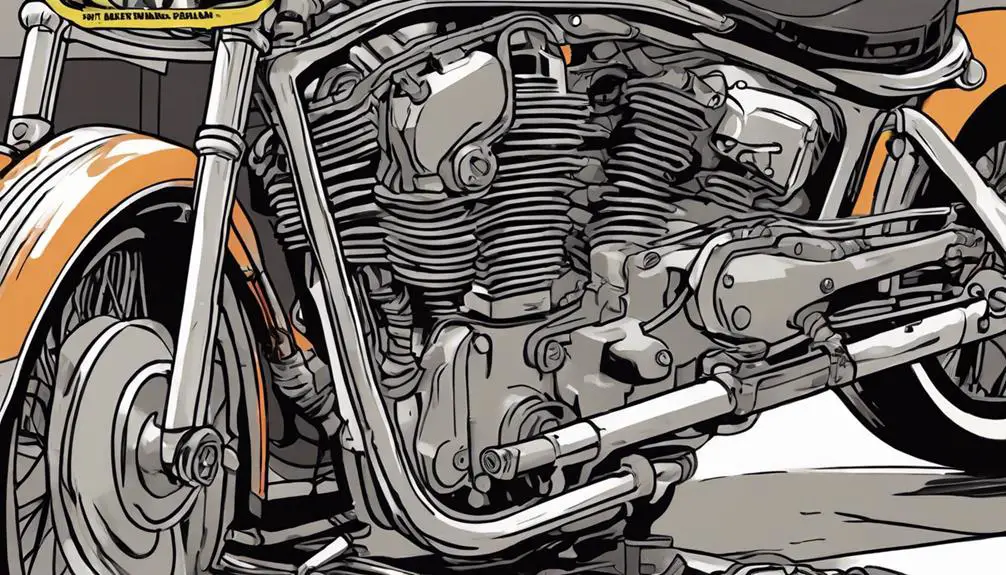
To tackle idle problems, start by inspecting your motorcycle's fuel system for clogs or leaks. This is where your ride's freedom begins, and any disruption can stifle your spirit on the open road.
First, check the fuel lines. Look for cracks or wear; even small leaks can lead to bigger issues down the line. If the lines seem fine, move on to the fuel filter. A clogged filter restricts fuel flow, and that can lead to frustrating idle problems. Replace it if it's dirty or hasn't been changed in a while.
Next, turn your attention to the fuel pump. A failing pump can struggle to deliver the necessary fuel pressure, leaving you feeling stranded. You can test it with a gauge to verify it's working properly. If you find any irregularities, consider replacing it.
Lastly, don't overlook the fuel itself. Old or contaminated fuel can cause your engine to sputter and stall. If you suspect this, drain the tank and refill it with fresh gas.
Inspect the Air Filter
Inspecting the air filter is essential, as a dirty or clogged filter can greatly impact your motorcycle's idle performance. When you ride, your engine craves a steady flow of clean air to maintain that smooth, powerful rhythm. If your air filter's blocked, it can choke your engine, leading to erratic idling or stalling.
Start by locating the air filter, which is usually near the intake manifold. Remove the cover and take a good look at the filter itself. If it's covered in dirt, dust, or debris, it's time for a clean or replacement. A simple wash with soap and water might do the trick for foam filters, while paper filters should usually be replaced entirely.
Keep in mind that an efficient air filter not only enhances your bike's performance but also contributes to better fuel efficiency. You'll feel the liberation of smooth acceleration and a steady idle when your engine breathes freely.
Regularly checking your air filter isn't just about maintenance; it's about ensuring your ride stays exhilarating and responsive. So hop to it and give your motorcycle the fresh air it deserves!
Adjust the Idle Speed
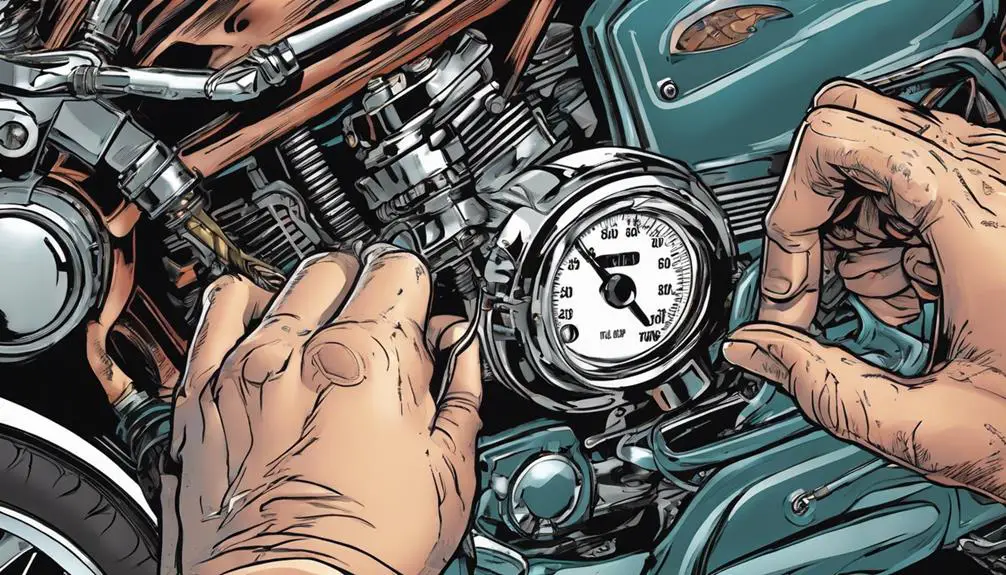
When you're adjusting the idle speed, start by locating the idle adjustment screw on your bike.
Make sure to check your manufacturer specifications for the correct settings.
After you've made the adjustments, test your bike to see how it performs.
Locate Idle Adjustment Screw
Finding the idle adjustment screw is essential for tuning your motorcycle's idle speed effectively. This screw controls how fast your engine idles when you're not revving it. To locate it, you'll often need to look around the carburetor or throttle body. Each bike is different, so don't hesitate to consult your manual or online resources for your specific model.
Once you've found it, grab a screwdriver that fits snugly. Be careful not to force it; you want to make precise adjustments. Remember, small turns can make a big difference, so start with a quarter turn and listen. You're tuning your ride, releasing it from those frustrating stalls and rough idles.
Make adjustments while your engine is warm for the best results. As you turn the screw, pay close attention to how the motorcycle responds. The goal is to achieve a smooth, steady idle that feels right under your fingertips.
This process isn't just about mechanics; it's about connecting with your machine and unlocking its true potential. So go ahead, take control of your ride, and enjoy the freedom of a finely tuned motorcycle!
Check Manufacturer Specifications
Before making any adjustments, it's crucial to check your motorcycle's manufacturer specifications for the recommended idle speed. This guarantees you're not just tinkering aimlessly but aligning your ride with its true potential.
You want your bike to purr, not sputter, so a quick glance at the owner's manual or a quick online search can save you a world of hassle.
Once you've located the ideal idle speed, gather your tools and get ready to release your motorcycle's performance.
Adjusting the idle speed isn't just about fixing problems; it's about freeing your ride from the constraints of improper tuning. Each model has its own unique specifications, so stick to the numbers provided by the manufacturer.
Test After Adjustments
After adjusting the idle speed, it's important to test the motorcycle to guarantee it's running smoothly and at the recommended specifications.
Start by firing up your bike and letting it warm up for a few minutes. Pay attention to how it idles; it should maintain a steady RPM without stalling or racing. If it falters, you might need to tweak the adjustments you just made.
Next, take your motorcycle for a short ride. This'll help you gauge its performance under actual riding conditions. Listen for any unusual sounds, and feel for vibrations that shouldn't be there. When you come to a stop, check if it idles consistently. If it dips or fluctuates, that's a sign you'll need to revisit your adjustments.
Don't forget to check the throttle response as well. You want to feel a smooth engagement without hesitation. If everything feels right, you've likely nailed the adjustment.
However, if something still feels off, don't hesitate to consult your manual or seek professional help. Getting your bike to run freely is all about that perfect balance, so keep fine-tuning until it feels just right. Enjoy the ride!
Examine the Spark Plugs
Spark plugs play an essential role in your motorcycle's performance, so checking their condition can reveal a lot about any idle issues you might be experiencing. When you examine your spark plugs, look for signs of wear, corrosion, or fouling. These indicators can signal that your engine isn't firing properly, leading to an unstable idle.
If the plugs are covered in black soot, your engine might be running too rich, meaning it's getting too much fuel. Conversely, if they're white and chalky, your engine could be running too lean, which indicates a fuel shortage. Both scenarios can cause rough idling and can hinder your freedom on the road.
Don't forget to check the gap between the electrodes; it should match your manufacturer's specifications. An incorrect gap can lead to misfires, further complicating your idle issues. If you notice any significant wear, you'll want to replace those plugs to restore peak performance.
Clean the Throttle Body
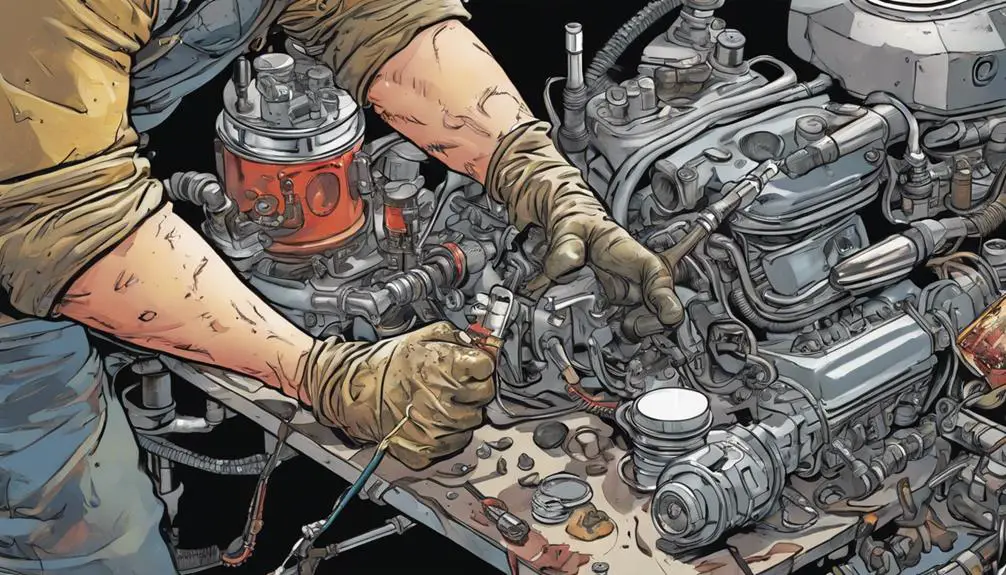
Examining the spark plugs gives you valuable insights, but another key area to address for idle issues is the throttle body, which can accumulate grime and affect airflow. When you clean the throttle body, you're taking a crucial step towards freeing your motorcycle from sluggishness and ensuring it runs smoothly.
First, gather your cleaning supplies: throttle body cleaner, a soft cloth, and a brush. Make sure your bike is turned off and cool. Remove the air intake hose to access the throttle body. You'll want to spray the cleaner directly onto the throttle plate and around the interior. As you do this, use a cloth or brush to gently scrub away any deposits. This buildup can restrict airflow, leading to poor idling and performance.
Once you've scrubbed it down, let it dry completely before reassembling everything. This simple yet powerful act of cleaning not only enhances airflow but also revitalizes your ride.
Test the Battery Voltage
Testing your battery voltage is essential for diagnosing idle problems, as a weak or failing battery can lead to inconsistent electrical performance in your motorcycle.
Grab a multimeter and set it to the DC voltage setting. Next, connect the red probe to the positive terminal and the black probe to the negative terminal of your battery. A healthy, fully charged battery should read around 12.6 volts or higher. If your reading is below 12.4 volts, it's time to charge or replace the battery.
While testing, keep an eye out for voltage drops when you engage the starter. If the voltage drops considerably, your battery may not have the power to keep the electrical systems running smoothly, leading to idle issues.
Don't forget to check the connections too; loose or corroded terminals can also cause voltage problems. Clean any corrosion and guarantee a snug fit.
Review the ECU Settings
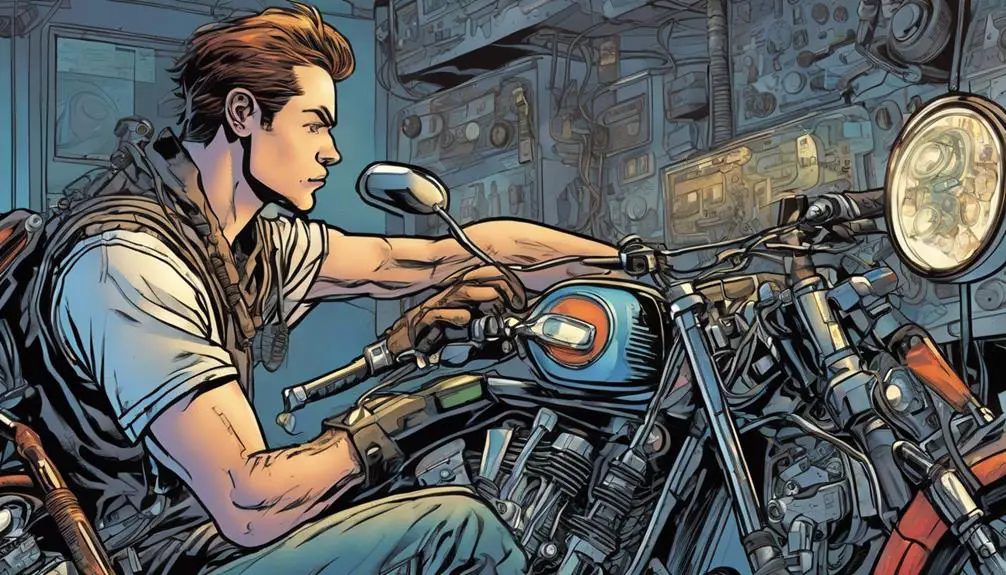
Before diving into other potential issues, it's crucial to review the ECU settings, as incorrect configurations can directly affect your motorcycle's idle performance.
Your ECU, or Engine Control Unit, is the brain of your bike, managing everything from fuel delivery to ignition timing. If these settings are off, you might notice erratic idling or stalling.
Start by checking if your ECU is calibrated for your specific bike model. If you've made modifications, like a new exhaust or air filter, the settings might need adjustments to enhance performance. Use a diagnostic tool to access the ECU and look for any error codes that might indicate a problem.
Next, verify that your idle speed is set correctly. Most motorcycles have a recommended RPM range for ideal idling. If your settings are too low, it could lead to a rough idle or stalling. Conversely, settings that are too high can wear out your engine prematurely.
Once you've adjusted the settings, take your bike for a test ride. Pay attention to how it idles. If it feels liberated and responsive, you're on the right track! If not, further investigation might be necessary.
Inspect Vacuum Leaks
When it comes to motorcycle idle issues, inspecting for vacuum leaks is essential.
You'll want to check common leak sources like hoses and gaskets, as they can considerably affect performance.
Once you identify potential spots, testing for leaks will help guarantee your bike runs smoothly.
Common Leak Sources
Inspecting for vacuum leaks is essential, as even a small crack can disrupt your motorcycle's idle performance. To release the full potential of your ride, you need to identify common leak sources.
Start with the intake manifold. Cracks or loose connections here can lead to unwanted air entering the system, messing with your fuel mixture.
Next, check the rubber hoses. These flexible lines can degrade over time, causing them to harden or crack. Look for any signs of wear or damage.
Don't forget to inspect the throttle body; a faulty gasket can create significant leaks, affecting your bike's responsiveness.
Also, pay attention to the vacuum petcock if your motorcycle has one. A malfunctioning petcock can allow air to seep in, leading to idle issues.
Testing for Leaks
To effectively address idle problems, you'll want to test for vacuum leaks, as even minor leaks can greatly affect your motorcycle's performance. Start by inspecting all the rubber hoses connected to the intake system. Look for cracks, holes, or any signs of wear that might let air escape. A simple visual check can reveal a lot, but don't stop there.
Next, grab a can of carburetor cleaner or brake cleaner. With the engine running, spray the cleaner around the hoses and intake manifold. If the idle speed changes, you've found a leak. This technique is a quick, efficient way to pinpoint issues without needing specialized tools.
You can also use a smoke machine, which introduces smoke into the intake system. This method clearly shows where leaks are located, as the smoke will escape from any openings.
Once you've identified and fixed any leaks, your motorcycle should idle more smoothly. Remember, addressing these leaks isn't just about improving performance; it's about liberating your ride from frustrating issues that hold you back. Embrace the freedom of a well-tuned machine!
Evaluate the Exhaust System
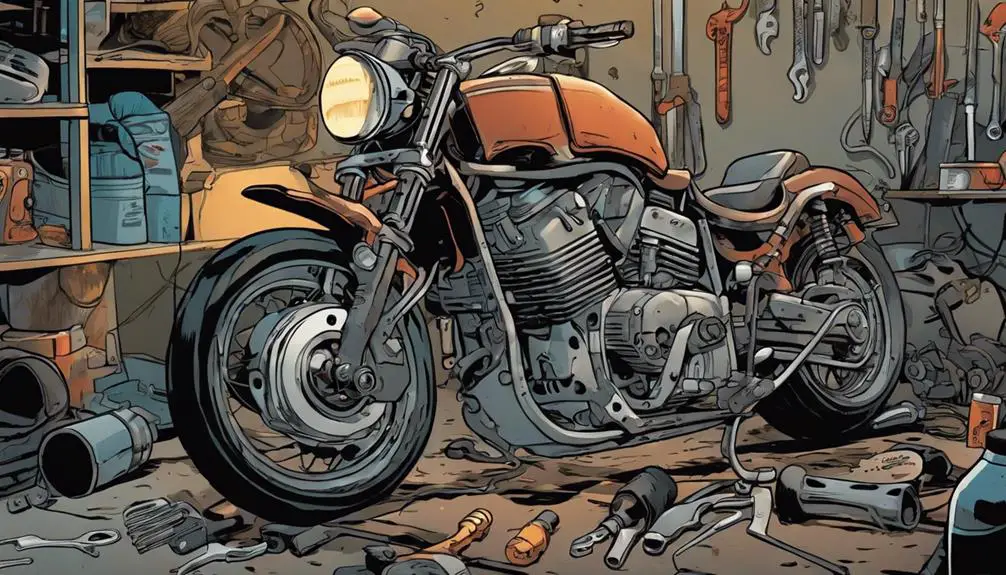
Evaluate the exhaust system for any leaks or blockages that could disrupt the motorcycle's idle performance. An unobstructed exhaust not only enhances your bike's power but also keeps it purring smoothly at low speeds.
Start by inspecting the exhaust pipes for any visible cracks or holes. Even the smallest leak can throw off your bike's air-fuel mix, leading to erratic idling.
Next, check for blockages in the muffler or catalytic converter. A clogged system can stifle the engine's breath, causing rough idling and sluggish acceleration. If you notice any rust or soot buildup, it might be time for a thorough cleaning or even replacement.
Don't forget to listen! An unusual rumbling or hissing sound can signal exhaust issues that need addressing. Remember, a free-flowing exhaust system contributes to your motorcycle's overall performance, giving you that liberating ride you crave.
Taking time to evaluate your exhaust system can lead to a more responsive engine and a smoother idle. Release your bike's potential by ensuring its exhaust is in top shape, and enjoy the freedom of the open road without the nagging interruptions of idle problems.
Seek Professional Help
Sometimes, troubleshooting your motorcycle's idle issues can be beyond your expertise.
Knowing when to consult experts can save you time and prevent further damage.
A professional diagnosis not only identifies the root cause but also guarantees your bike runs smoothly again.
When to Consult Experts
Knowing when to seek professional help for motorcycle idle issues can save you time and prevent costly repairs down the road. If you've tried basic fixes like adjusting the idle speed or cleaning the carburetor and your bike still stutters or stalls, it's time to call in the experts.
Don't ignore persistent symptoms, as they can lead to more significant problems that might compromise your freedom on the road.
You should also consult a professional if you notice unusual noises or vibrations while idling. These could indicate deeper mechanical issues that require specialized knowledge. Trust your instincts; if something feels off, it probably is.
Additionally, if you lack the tools or experience to diagnose the problem accurately, don't hesitate to reach out for help. Resistance to asking for assistance can lead to misguided attempts at repairs, ultimately costing you more in the long run.
Benefits of Professional Diagnosis
Seeking a professional diagnosis can quickly pinpoint the root cause of your motorcycle's idle problems, saving you time and frustration. When you hand over your bike to an expert, you're not just getting a service; you're investing in your freedom to ride without worry.
Professionals have the experience and tools to identify issues that might elude the untrained eye, ensuring that no problem goes unchecked. By opting for a professional diagnosis, you also gain peace of mind. You won't have to second-guess your DIY fixes or live in uncertainty about your bike's performance.
Instead, you'll receive a clear, informed assessment of what's wrong, allowing you to make smart decisions about repairs. Additionally, a professional can often spot underlying issues that might lead to bigger problems down the road. This proactive approach helps you avoid unexpected breakdowns and costly repairs, ultimately liberating you from the stress of motorcycle maintenance.
Frequently Asked Questions
How Do I Know if My Motorcycle Has an Idle Problem?
You'll know your motorcycle has an idle problem if it stalls unexpectedly, struggles to maintain a steady RPM, or makes unusual noises when idling.
Pay attention to vibrations or if the engine feels rough.
If you notice a fluctuating idle speed or if it won't start easily, you might be facing an issue.
Trust your instincts; if something feels off, it's worth investigating further to reclaim your ride's performance.
Can Weather Conditions Affect My Motorcycle's Idle?
Absolutely, atmospheric alterations can affect your motorcycle's idle!
Changes in temperature and humidity can lead to inconsistent combustion, causing your engine to struggle.
When it's chilly, your bike might need more time to warm up, while heat can make it run lean.
What Tools Do I Need for Motorcycle Maintenance?
For motorcycle maintenance, you'll need a few essential tools to keep your ride in top shape.
Grab a basic tool kit including wrenches, screwdrivers, and pliers.
A torque wrench helps with precise adjustments, while a tire pressure gauge guarantees your tires are ready for the road.
Don't forget a good set of gloves and a clean rag for oil changes.
With these tools, you're empowered to maintain your freedom on two wheels!
Are Idle Problems Specific to Certain Motorcycle Models?
Idle problems can affect various motorcycle models, but they're not limited to just a few.
You'll find that some brands have more common issues due to design or engineering choices.
By paying attention to your bike's specific needs, you can diagnose and fix these problems effectively.
Embrace the freedom of understanding your ride, explore the unique quirks of your model, and take charge of your motorcycle's performance for a smoother journey ahead.
How Often Should I Perform Routine Maintenance to Prevent Idle Issues?
You should perform routine maintenance on your motorcycle every 3,000 to 5,000 miles, or at least twice a year, depending on your riding habits.
Keeping your bike clean and checking the oil, air filter, and spark plugs regularly will help you avoid idle issues.
Don't wait for problems to arise; staying proactive guarantees a smooth ride and lets you enjoy the freedom of the open road without worry.
Conclusion
By addressing motorcycle idle problems with these top solutions, you can guarantee a smoother ride and enhance your overall experience.
Did you know that nearly 30% of motorcycle breakdowns stem from fuel system issues? Taking the time to inspect and maintain your bike can save you from being stranded or facing costly repairs.
So, don't wait for the problem to escalate—tackle these tips today, and keep your bike running like a dream!